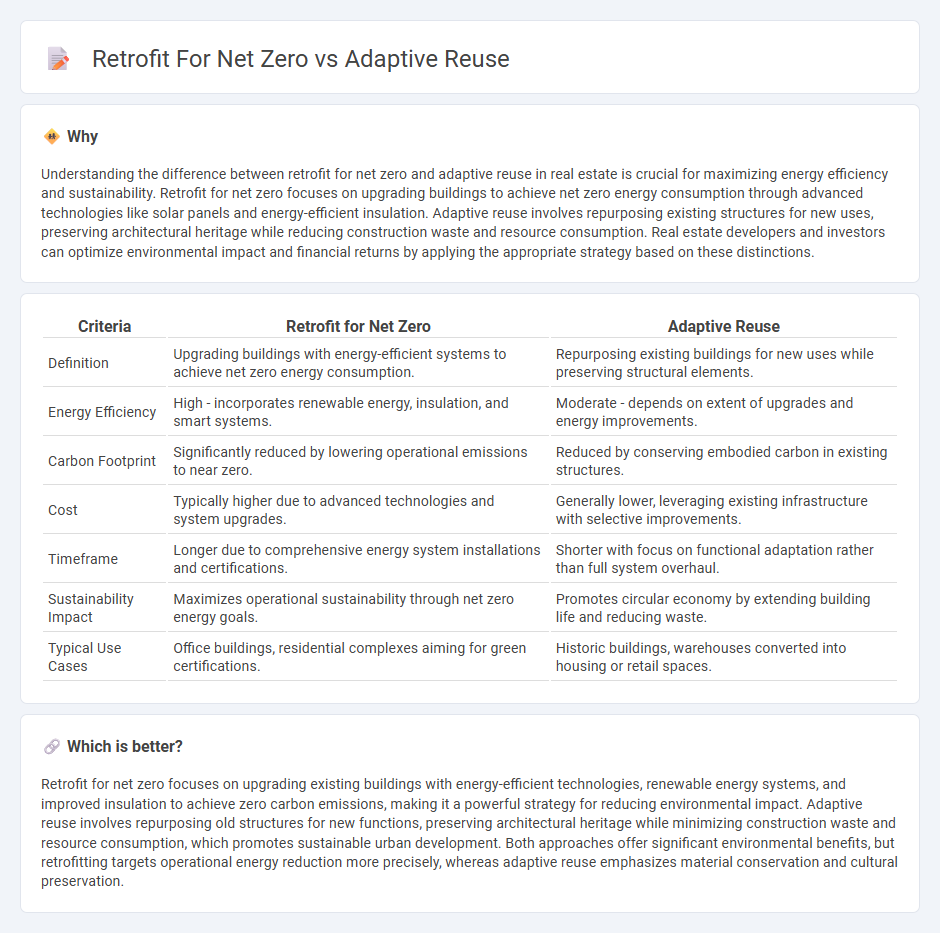
Retrofitting for net zero focuses on upgrading existing buildings to achieve zero carbon emissions by enhancing energy efficiency and incorporating renewable energy systems. Adaptive reuse transforms outdated structures into new functional spaces while preserving historical elements and reducing construction waste. Explore the benefits and challenges of both strategies to decide the best sustainable approach for your real estate project.
Why it is important
Understanding the difference between retrofit for net zero and adaptive reuse in real estate is crucial for maximizing energy efficiency and sustainability. Retrofit for net zero focuses on upgrading buildings to achieve net zero energy consumption through advanced technologies like solar panels and energy-efficient insulation. Adaptive reuse involves repurposing existing structures for new uses, preserving architectural heritage while reducing construction waste and resource consumption. Real estate developers and investors can optimize environmental impact and financial returns by applying the appropriate strategy based on these distinctions.
Comparison Table
| Criteria | Retrofit for Net Zero | Adaptive Reuse |
|---|---|---|
| Definition | Upgrading buildings with energy-efficient systems to achieve net zero energy consumption. | Repurposing existing buildings for new uses while preserving structural elements. |
| Energy Efficiency | High - incorporates renewable energy, insulation, and smart systems. | Moderate - depends on extent of upgrades and energy improvements. |
| Carbon Footprint | Significantly reduced by lowering operational emissions to near zero. | Reduced by conserving embodied carbon in existing structures. |
| Cost | Typically higher due to advanced technologies and system upgrades. | Generally lower, leveraging existing infrastructure with selective improvements. |
| Timeframe | Longer due to comprehensive energy system installations and certifications. | Shorter with focus on functional adaptation rather than full system overhaul. |
| Sustainability Impact | Maximizes operational sustainability through net zero energy goals. | Promotes circular economy by extending building life and reducing waste. |
| Typical Use Cases | Office buildings, residential complexes aiming for green certifications. | Historic buildings, warehouses converted into housing or retail spaces. |
Which is better?
Retrofit for net zero focuses on upgrading existing buildings with energy-efficient technologies, renewable energy systems, and improved insulation to achieve zero carbon emissions, making it a powerful strategy for reducing environmental impact. Adaptive reuse involves repurposing old structures for new functions, preserving architectural heritage while minimizing construction waste and resource consumption, which promotes sustainable urban development. Both approaches offer significant environmental benefits, but retrofitting targets operational energy reduction more precisely, whereas adaptive reuse emphasizes material conservation and cultural preservation.
Connection
Retrofitting for net zero focuses on upgrading existing buildings with energy-efficient technologies and renewable energy systems to achieve zero carbon emissions, which directly enhances the sustainability of adaptive reuse projects by minimizing environmental impact. Adaptive reuse leverages the structural integrity of existing real estate assets while integrating net zero retrofits to reduce operational energy demands and extend building lifespans. Both strategies synergize to promote sustainable urban development, reduce construction waste, and meet stringent green building certification standards such as LEED and WELL.
Key Terms
Building Envelope
Adaptive reuse transforms existing structures by integrating energy-efficient materials and technologies into the building envelope, significantly reducing embodied carbon and preserving architectural heritage. Retrofit focuses on upgrading insulation, windows, and airtightness to enhance thermal performance and minimize energy demand while maintaining structural integrity. Explore advanced strategies for optimizing building envelopes and achieving net zero goals in your next project.
Energy Efficiency
Adaptive reuse involves repurposing existing buildings to reduce embodied carbon, often achieving higher energy efficiency through modern insulation and HVAC upgrades, while retrofit focuses on enhancing current systems within a building to improve performance without major structural changes. Both strategies aim to meet net zero energy goals by minimizing energy consumption and incorporating renewable energy solutions, but adaptive reuse typically offers greater potential for holistic design improvements. Explore how combining these approaches can optimize energy efficiency in net zero projects.
Carbon Footprint
Adaptive reuse minimizes carbon footprint by repurposing existing structures, significantly reducing embodied carbon compared to new construction. Retrofit focuses on upgrading building systems for energy efficiency but may still incur substantial embodied carbon due to material replacements. Discover detailed strategies to balance carbon savings between adaptive reuse and retrofit for achieving net zero emissions.
Source and External Links
Adaptive Reuse - Wikipedia - Adaptive reuse involves repurposing existing buildings for new uses, promoting sustainability and reducing environmental impact by extending the buildings' lifespan.
What is adaptive reuse (and why is it important)? - This webpage discusses adaptive reuse as a sustainable process that reuses buildings for different purposes, highlighting its benefits over traditional demolition and construction methods.
A Complete Guide to Adaptive Reuse in 2023 - MBH Architects - This guide outlines various types of adaptive reuse projects, including renovation, integration, preservation, facadism, and infrastructural reuse, offering insights into sustainable building practices.
 dowidth.com
dowidth.com